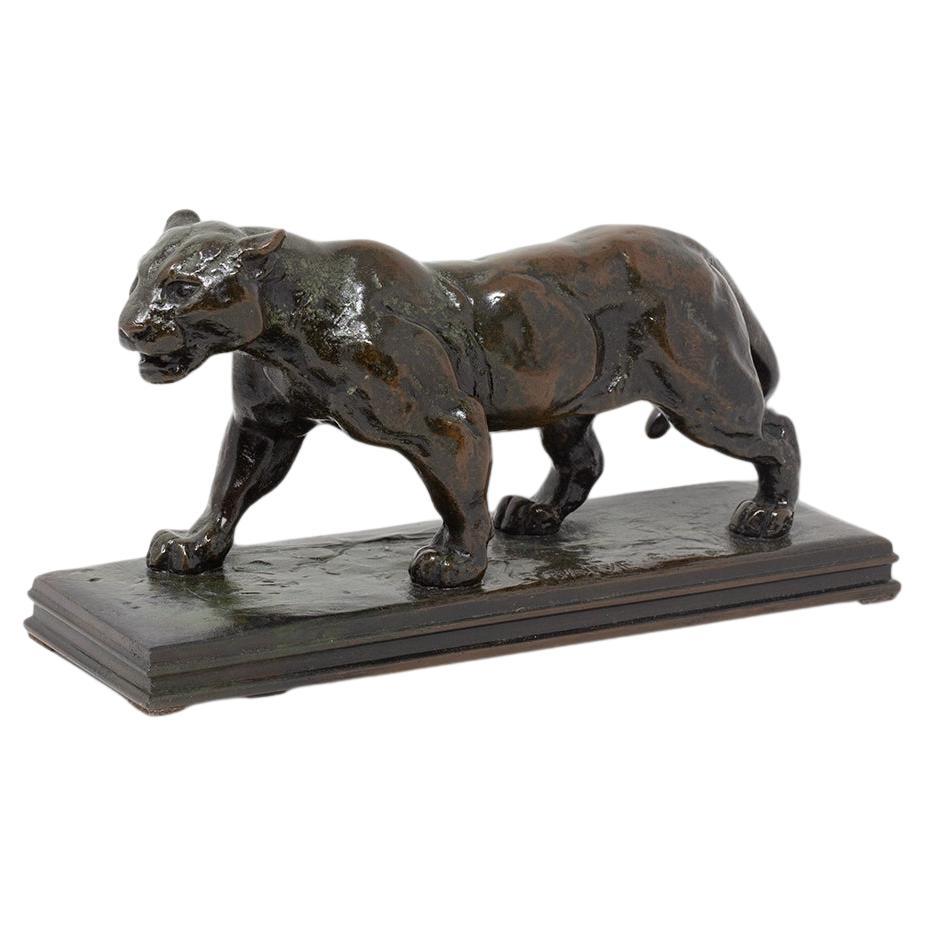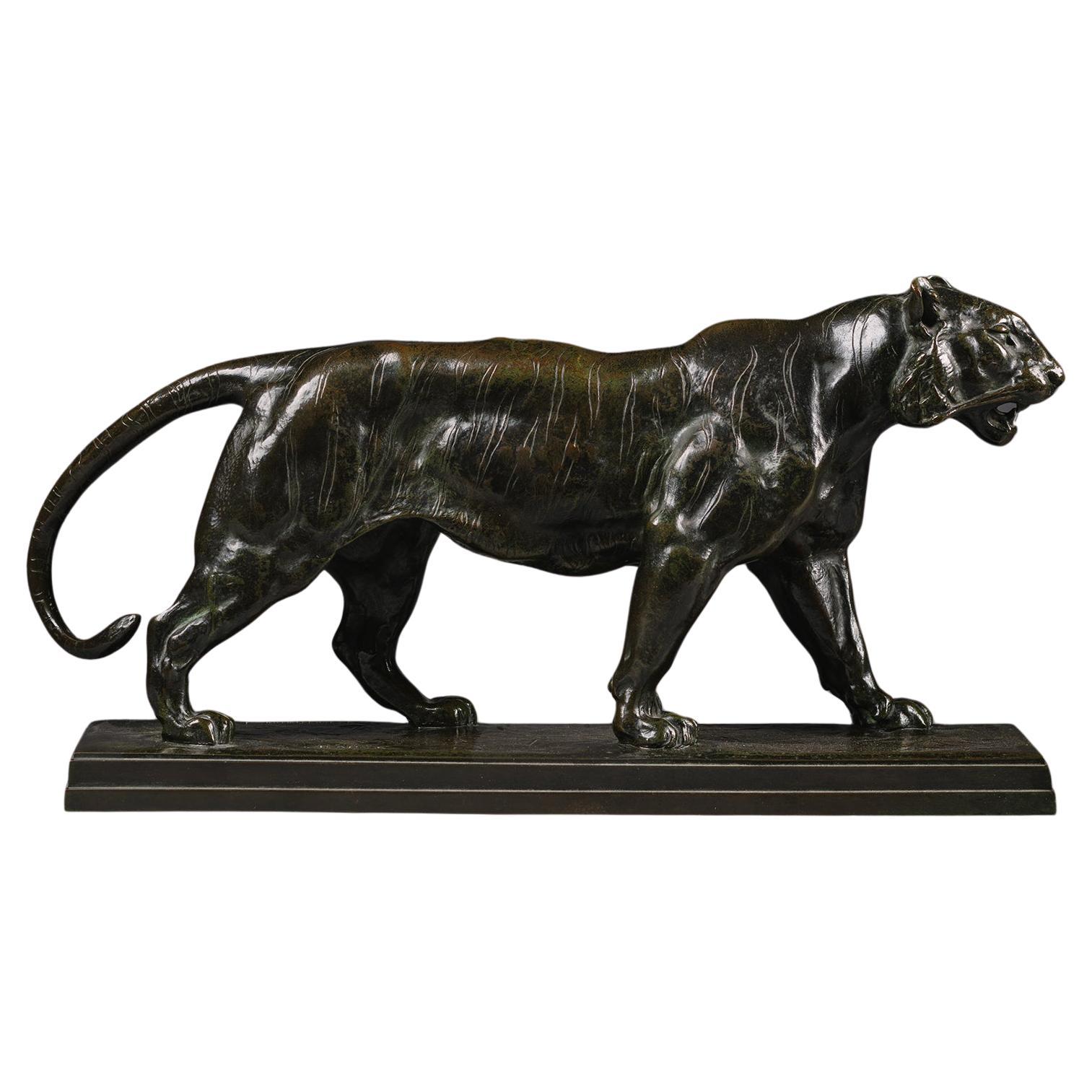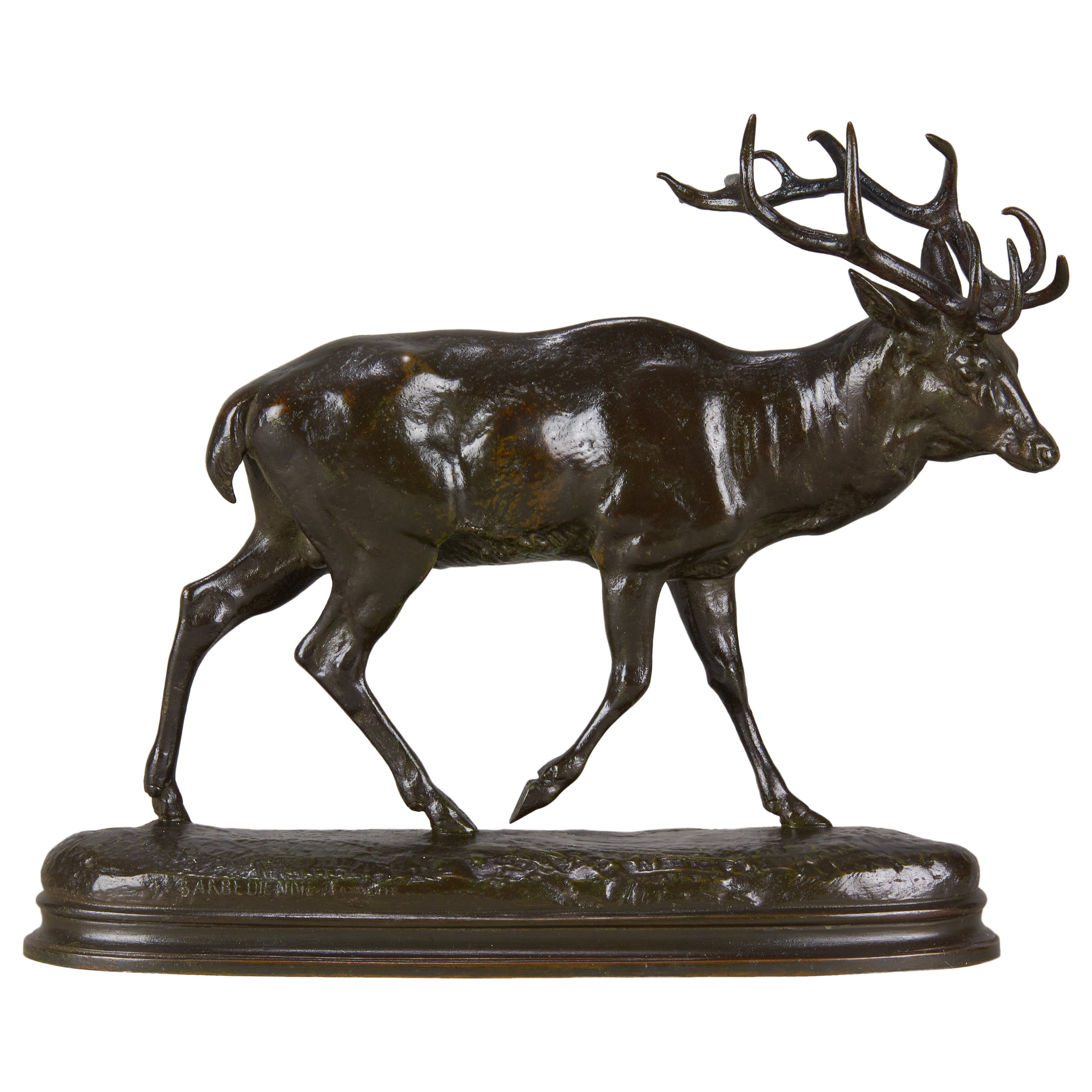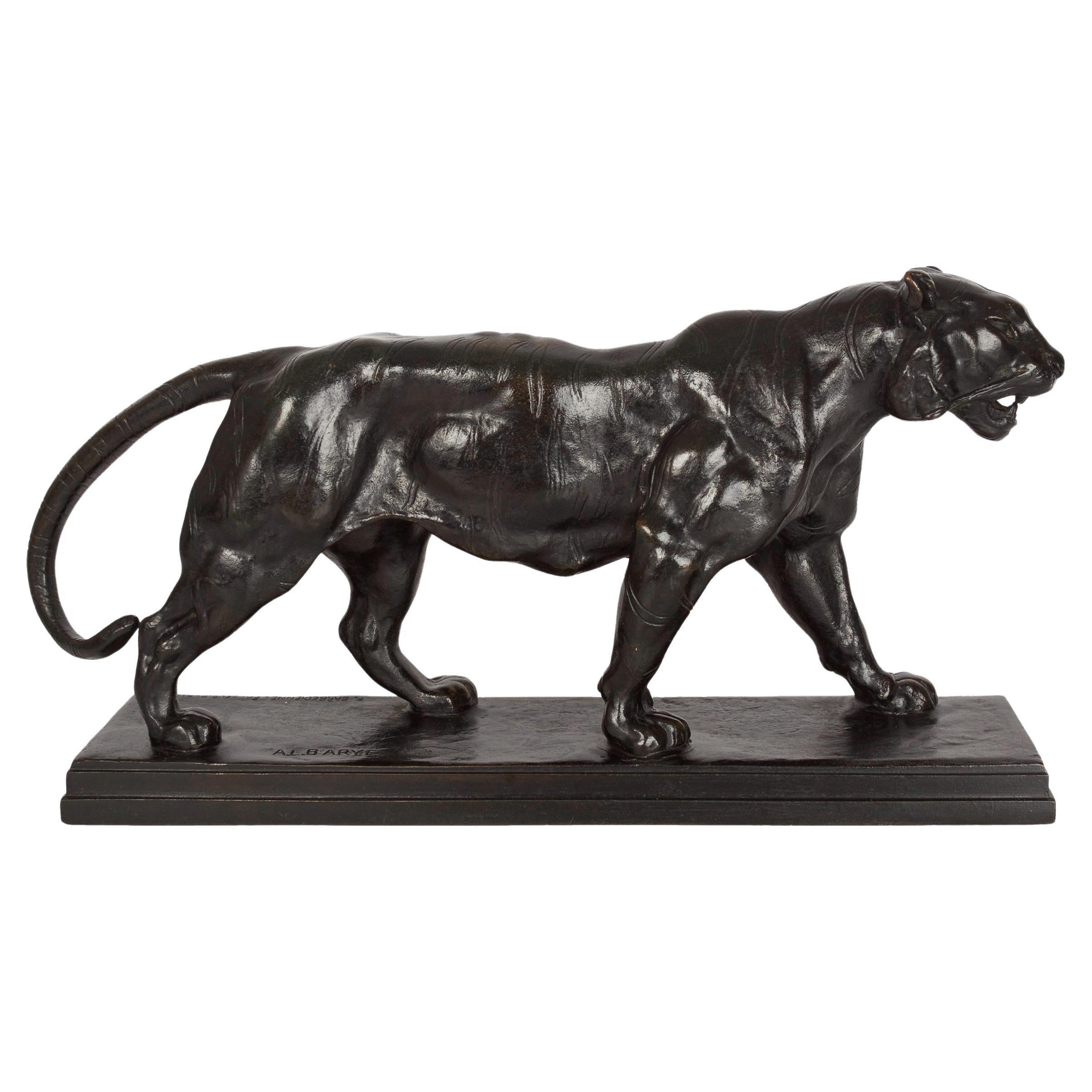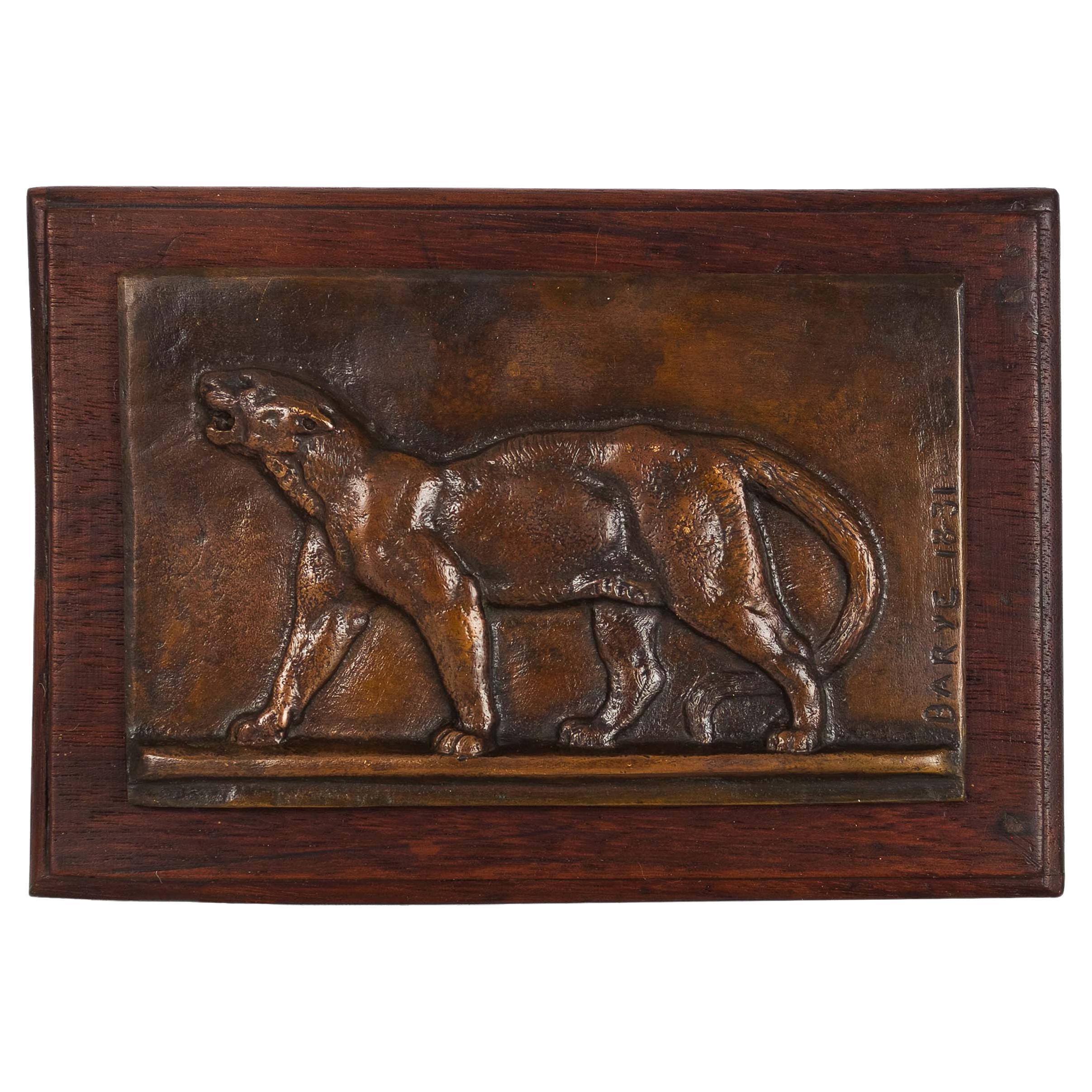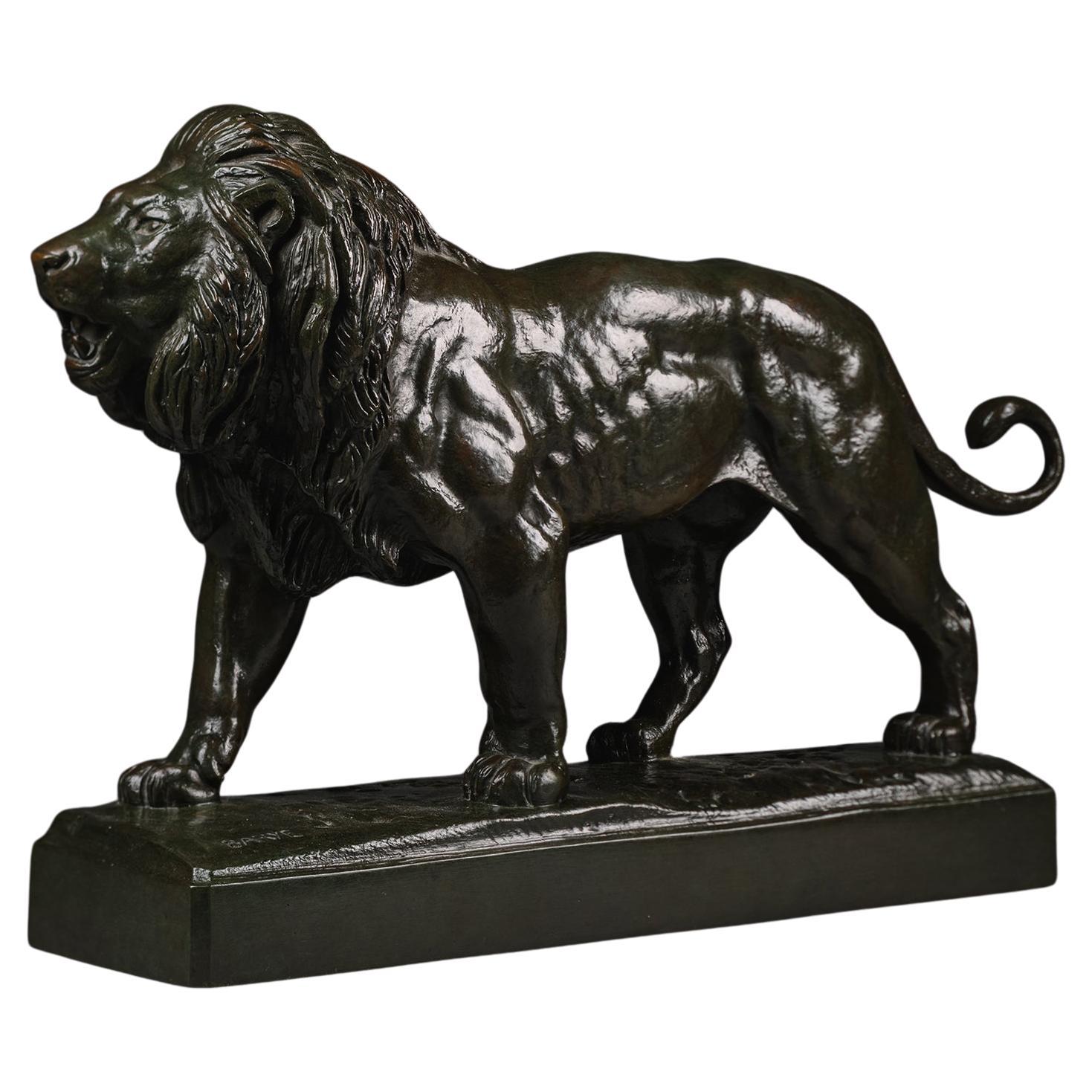Items Similar to After Antoine-Louis Barye Walking Lion Le lion qui marche White Marble Effect
Want more images or videos?
Request additional images or videos from the seller
1 of 5
After Antoine-Louis Barye Walking Lion Le lion qui marche White Marble Effect
About the Item
Antiquarian Marble -Effect, Walking White Lion
The white lion, roaring and striding forwards.
On a plinth decorated with greek key ornament.
White marble effect resin.
After the antique, in bronze by Antoine-Louis Barye (French, Paris 1795–1875 Paris) Walking Lion (Le lion qui marche) Metropolitan Museum New York No X.420, dimensions 8 3/4 × 4 1/2 × 15 5/8 in. (22.2 × 11.4 × 39.7 cm)
Antoine-Louis Barye cast the first example of Lion qui marche circa 1840 (M. Poletti & A. Richarme, Barye, fig. A 61, p. 187). Although over 100 épreuves of were cast during the sculptor's lifetime, the popularity of the models and proliferation of casts can be credited directly to the foundry Barbedienne, who edited both, numerously and in large quantities, from Barye's death, right up to the Second World War.
Antoine-Louis Barye’s lifelike depictions of wild animals made him the most famous animal sculptor of the nineteenth century, he was known as an ‘animalier’.
Given the lion's associations with power and strength it is befitting that Barye cemented his reputation with his depeiction of ‘Un lion assis’ (‘Seated Lion’), dated 1847 (porte des Lions, Louvre Paris). Bayre had sculpted lions before this date and returned to the subject with many variations after, reworking models of walking lions under the titles ‘Lion qui marche’ and ‘Lion marchant’. Examples of which are recorded in all major museum collections including the Louvre and the MET.
WHITE LIONS
They are as rare as they are beautiful – stunning white lions, whose ancestral home is the Timbavati Region in the Greater Kruger area of South Africa. They are synonymous with the area, with the name Timbavati coming from the ancient XiTsonga language, meaning “the place where star-lions came down”.
White lions have a special place in African folklore and history, with legends telling that they were “children of the Sun God” and were “sent to earth as gifts”. Over 400 years ago, they were said to have been seen during the reign of Queen Numbi. They are considered to be “the most sacred animal on the African continent”, according to the Sepedi and Tsonga communities. They are known as symbols of leadership, pride, and royalty in some African countries, including Kenya and Botswana.
White lions have an ethereal quality to them, with dreamy-looking eyes, and a purity that seems angelic. They appear in various types of popular culture, including books, movies, paintings, and the cartoon character “Kimba the White Lion”, and are used in brand names and advertising.
There are only four white lions in the wild – a male in the Kruger National Park, a young male and related female of Timbavati’s mighty Birmingham Pride, and a newly-spotted cub, also in the Timbavati. That cub is so new that reports of its presence are only just beginning to come from safari guides in the area.
capturedinafricafoundation
- Dimensions:Height: 9.45 in (24 cm)Width: 14.18 in (36 cm)Depth: 5.12 in (13 cm)
- Style:Baroque (In the Style Of)
- Materials and Techniques:
- Place of Origin:
- Period:
- Date of Manufacture:circa 1960
- Condition:Wear consistent with age and use.
- Seller Location:BUNGAY, GB
- Reference Number:1stDibs: LU3867322315302
About the Seller
5.0
Vetted Seller
These experienced sellers undergo a comprehensive evaluation by our team of in-house experts.
Established in 1985
1stDibs seller since 2018
84 sales on 1stDibs
Typical response time: 12 hours
- ShippingRetrieving quote...Ships From: BUNGAY, United Kingdom
- Return PolicyA return for this item may be initiated within 7 days of delivery.
More From This SellerView All
- Lions Pair of Sculpture Marble Italian 13th Century RomanesqueLocated in BUNGAY, SUFFOLKRare, pair of 13th century, Romanesque, marble, recumbent lions Recumbent lions were popular in 11th-13th century Italian architecture with pairs ...Category
Antique 15th Century and Earlier Italian Classical Roman Animal Sculptures
MaterialsMarble
- Brunswick Lion Bronze German Model Black Marble, 19th CenturyLocated in BUNGAY, SUFFOLKA German bronze model of the medieval Brunswick lion, mounted on a black marble plinth, late-19th century, The German prince, Henry, Duke of Saxony an...Category
Antique 1880s German Baroque Revival Animal Sculptures
MaterialsBronze
- Lion Stone Sculpture Architectural Garden RenaissanceLocated in BUNGAY, SUFFOLKThis sculpture has taken on a different character over time as it has weathered and the detailing has softened. Time has given it a pared down, minimalist quality juxtaposing the R...Category
Antique 16th Century English Renaissance Statues
MaterialsLimestone
- Sculpture Marble Bird SingingLocated in BUNGAY, SUFFOLKCharming sculpture of a bird perched on a bough singing. Measures: length 6cm., 2 1/2" depth 5cm., 2" height 13cm., 5".Category
Antique 19th Century Italian Victorian Animal Sculptures
MaterialsMarble
- Bookends Sculpture Mouse Bronze Marble Art Deco Playful KnowledgeLocated in BUNGAY, SUFFOLKUnusual, fun, pair of art deco, marble and bronze, mouse, sculpture bookends. One mouse is absorbed acquiring knowledge reading a book and the other is curiously looking towards the...Category
Vintage 1930s English Art Deco Animal Sculptures
MaterialsMarble, Bronze
- Alan Wallwork Vessel Vase Pottery Sculpture TOTEM White Brown TerracottaLocated in BUNGAY, SUFFOLKAlan Wallwork (1931-): Organic landscape sculptural vessel, 1960-1965 Exhibiting the articulated, inventive, organic qualities & tactility of Wallwork’s early oeuvre for which he is best known - This sculptural landscape vessel has been handmade by coiling, slabbing and shaping the clay. The totemic form and pitted and pierced surfaces draw on the abstract landscape and tactility of elements in nature. matte glazes and oxides have been skillfully used to enhance the rich textures of the surfaces and the organic aesthetic. - Wallwork is one of the great individualists in British pottery, developing an archetypal language that echoed some of the wider artistic obsessions of that period, what the art critic Herbert Read called the “postwar ferment” of sculptural activity. - This piece was made during 1960-1965, the time that Wallwork was sharing a studio in Greenwich with Bernard Rooke and comes from a private collection along with a waterscape vase by Rooke and a bottle by Robert Fournier...Category
Vintage 1960s British Mid-Century Modern Vases
MaterialsPottery
You May Also Like
- Jaguar Qui Marche No. 2 (Walking Jaguar) Antoine L BaryeBy Antoine-Louis BaryeLocated in Newark, EnglandFrom our Sculpture collection, we are delighted to offer this Jaguar Qui Marche No. 2 (Walking Jaguar) Bronze by Antoine-Louis Barye. The Jaguar Qui Marche translates directly to Jag...Category
Antique Mid-19th Century French Louis Philippe Animal Sculptures
MaterialsBronze
- Antoine-Louis Barye (French, 1795-1875) 'Tigre qui Marche'By Antoine-Louis BaryeLocated in Brighton, West SussexAntoine-Louis Barye (French, 1795-1875) 'Tigre qui Marche' Bronze with dark brown patina. Signed 'BARYE' and with the foundry mark 'F. BARBEDIENNE. Fondeur' on the base. France, C...Category
Antique 19th Century French Animal Sculptures
MaterialsBronze
- "Cerf Qui Marche" by A L BaryeBy Antoine-Louis BaryeLocated in London, GBExcellent late 19th Century French bronze figure of a walking stag with beautiful autumnal, green. black. brown and orange patination and excellent hand finished surface detail on an oval naturalistic base with integral stepped plinth, signed Barye and inscribed F Barbedienne Fondeur ADDITIONAL INFORMATION Measures: Height: 19 cm Width: 22 cm Condition: Excellent Original Condition Circa: 1870 Foundry: F Barbedienne Materials: Bronze Book Ref Barye by Michel Poletti & Alain Richarme ABOUT Antoine Louis Barye “The Michelangelo of the Menagerie” These are the words of Théophile Gautier in praise of Barye’s genius. Throughout his life Barye endeavoured to capture the fundamental nature of the animal kingdom in all its diversity, wild or tame, exotic or familiar, cruel or gentle, bringing to life the roaring, trembling, living beasts. The son of a goldsmith, apprenticed to a steel engraver at a young age, Barye found himself making moulds for ornaments, acquiring knowledge that he would later build on to produce his exquisitely chased bronzes. When he was called up at seventeen, he joined the army’s topographic brigade where he used clay to model raised relief maps...Category
Antique Mid-19th Century French Art Nouveau Animal Sculptures
MaterialsBronze
- French Bronze Sculpture "Tiger Walking" after Antoine-Louis Barye, BarbedienneBy F. Barbedienne Foundry, Antoine-Louis BaryeLocated in Shippensburg, PAANTOINE-LOUIS BARYE French, 1795-1875 "Tigre Qui Marche" Dark brown patinated bronze Signed in base "A.L. BARYE", incised "F. BARBEDIENNE FONDEUR, PARIS", cold-stamped FRANCE cold-tooled to underside 19.691 conceived 1841, cast circa early 20th century Item # 111GPP20Q Barye's ability to merge our romantic idealization of nature with a colder reality of nature's predator is beautifully represented in this striding cat. Originally conceived in 1841, Tigre Qui Marche (Walking Tiger...Category
Early 20th Century French Romantic Animal Sculptures
MaterialsBronze
- French Bronze Sculpture Bas-Relief "Walking Leopard" after Antoine-Louis BaryeBy Antoine-Louis BaryeLocated in Shippensburg, PAANTOINE-LOUIS BARYE (AFTER) France, 1796-1875 "WALKING LEOPARD" (conceived 1831, cast circa 1890-1910) Patinated bronze bas-relief plaque on walnut panel Signed "BARYE 1831" Item # 110CFX23P A beautifully textured and well-preserved bas-relief plaque after Antoine-Louis Barye's Walking Leopard mounted...Category
Antique 19th Century French Romantic Animal Sculptures
MaterialsBronze
- Antoine-Louis Barye (French, 1795-1875) 'Lion marchant'By Antoine-Louis BaryeLocated in Brighton, West SussexAntoine-Louis Barye (French, 1795-1875) 'Lion marchant' bronze with dark brown patina signed 'BARYE' on the base and with the foundry mark 'HB / C' to underside for Maison H. Brame. France, Circa 1880. Antoine-Louis Barye’s remarkably lifelike depictions of wild animals made him the most famous animal sculptor of the nineteenth century and he is credited with making small animal bronzes cast in bronze a recognised genre. Such artists became known as ‘animaliers’. Given the associations with power and strength it is befitting that Barye cemented his reputation with his depeiction of ‘Un lion assis...Category
Antique 19th Century French Animal Sculptures
MaterialsBronze
